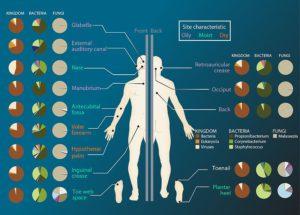Researchers from the Baylor College of Medicine investigated how the infant microbiome developed from birth into the diverse set of microbes that make up this complex immunological system. They found that the infant microbiome progressively matured from birth and that by just 6 weeks of life the microbiome had diversified significantly across different sites of the body. The researchers also found few differences in the microbiome profiles of babies delivered by the different modes of delivery.
The microbiome is a mixture of microorganisms including bacteria, fungi and viruses which have evolved with humans and are resident in our bodies. These microbes are beneficial in the maintenance of a healthy immune system and their disruption and decrease in diversity have been linked to several medical conditions.
To get a better picture of how the microbiome contributes to various disease states, the mechanism behind how the microbiome develops needs to be understood. Researchers, led by Kjersti Aagaard, investigated microbiota development in newborn infants.
The researchers enrolled mother-child pairs and took samples from the infants at birth and 4-6 weeks after delivery. They took samples from the skin, mouth, nares, stool, posterior fornix as well as the vaginal introitus. They chose to take the last samples after 4-6 weeks because by that time the children were still not exposed to large varieties of environmental microbes and because their diets were still quite homogeneous as they had not yet been introduced to solid foods.
The scientists found that microbiome of the infants was homogenous at the time of birth. By homogenous they meant that of the different microbes present at birth, none were characteristic of a particular site that was sampled unlike in the maternal samples. In contrast, at the 6 week timepoint, the infants’ microbiota had substantially diversified in terms of both structure and function.
The researchers also investigated how the mode of delivery – either Cesarean or vaginal birth – would influence the development of the infant microbiome. They found variations in newborns’ microbiota in the oral gingiva, nares and skin that were associated with Cesarean delivery mode. However, the function of the newborn microbiota stayed the same regardless of mode of delivery. By the 6-week time point, there was no difference in the structure and function of infants delivered by the different modes.
This study is currently the largest study to analyze the structure and function of the infant microbiome across the different sites of the body. By as early as 6 weeks of life, the infant microbiome had substantially matured and diversified. Importantly, the researchers did not identify differences in the function of the microbiota depending on the mode of delivery.
Article by Thandeka Moyo












